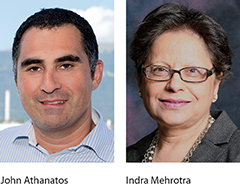 To feed the planet we need to not only consider food security (hunger), but, more importantly, “nutrition security” as well. Nutrition security takes food security one step further by addressing the complex global issues and challenges inherent in delivering the essential nutrients required to support human nutrition throughout the lifespan. Nutrition security affects both developed and developing countries—although in different ways. Some regions suffer from chronic diseases stemming from overnutrition, such as obesity, diabetes, heart disease, and stroke, while in other parts of the world people do not have access to the calories and nutrients required to support normal growth and development. As developed countries face rising homeless populations, they are encountering both of these public health challenges.
To feed the planet we need to not only consider food security (hunger), but, more importantly, “nutrition security” as well. Nutrition security takes food security one step further by addressing the complex global issues and challenges inherent in delivering the essential nutrients required to support human nutrition throughout the lifespan. Nutrition security affects both developed and developing countries—although in different ways. Some regions suffer from chronic diseases stemming from overnutrition, such as obesity, diabetes, heart disease, and stroke, while in other parts of the world people do not have access to the calories and nutrients required to support normal growth and development. As developed countries face rising homeless populations, they are encountering both of these public health challenges.
In the May-June issue of Cereal Foods World (CFW), we curate a spectrum of articles from authors around the world who offer insights into and solutions to address these important global nutrition problems. We are inspired by the possibilities these authors explore as they help us find new paths forward toward addressing global nutrition security: 1) use of science and technology to infuse vital nutrients into crops and food products that are already staples in feeding the planet; 2) how well-conceived and -executed public–private partnerships can positively affect public health and food security; and 3) the beneficial role whole grains can play in diet, health, and sustainability. Finally, consumer health and nutrition trends and how they offer opportunities for cereals and grains are discussed.
In their feature article, Michael Listman and his colleagues (CIMMYT) present a case study describing how biofortification is being utilized to increase the nutrient density of wheat and maize. Because these crops are staples in the diets of many people around the world, they are able to deliver more nutrients per calorie to a large number of people and have a major beneficial impact on global nutrition. Jenny Walton’s (HarvestPlus) companion article provides a systems view of the same biofortification project. She shares the overall strategy and tactics used to engage organizations at every level of the food value chain to support this nutrition initiative.
Also featured in this issue are two articles on public–private partnerships that are making a difference in nutrition security. The strategies and techniques discussed showcase best practices that could be used as guides for other nutrition leaders in academia, industry, and public health. In their article on the Danish Whole Grain Partnership, Sofia Lourenço and her colleagues in the partnership validate their public–private model for increasing whole grain consumption. Rizwan Yusufali and Tobi Durotoye, working with TechnoServe and Partners in Food Solutions, present a case study on how flour fortification, a seemingly simple technology used to address malnutrition in Africa, can still be challenging to implement and requires engagement by all stakeholders.
The Issues and Trends section of the issue includes a triad of articles that explore how whole grains can make a positive impact on sustainability, nutrition and diet, and cardiovascular health. Nicola McKeown and Tim Griffin (Tufts University) connect the dots between nutrition and sustainability, introducing new concepts for cereal scientists to consider, such as sustainable intensification and crop diversification. Chris Seal (Newcastle University) proposes important considerations for global policy makers as they address the challenges inherent in crafting regional and global nutrition recommendations concerning consumption of whole grains and whole grain foods. Caleigh Sawicki, Kara Livingston, and Nicola McKeown (Tufts University), provide further validation for the role of whole grains in cardiovascular health.
Vanessa Costa and Andrea Johnson (Eat Right Global) share their insights on consumer trends in health and nutrition and how they view cereals and grains. While acknowledging the headwinds generated by negative consumer perceptions of cereals and grains, they paint an exciting picture of growth in positive perceptions and the potential for inclusion of cereals and grains in healthy and sustainable diets around the world.
Finally, a spotlight is shown on Partners in Food Solutions, an organization that is making an impact on global food and nutrition insecurity. We are also pleased to recognize in the member spotlight column our colleague Kathy Wiemer, a long-standing AACCI member who has contributed to cereal and grain science and policy throughout her 40 year career at General Mills. (Kathy also served as a guest editor for the 2018 May-June issue of CFW.)
